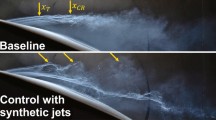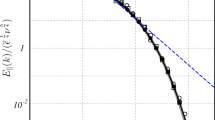Abstract
A visualization study is conducted on the excited laminar-turbulent transition within a flat plate boundary layer flow in a water tunnel. The hydrogen bubble technique is employed to investigate the complex characteristics of the flow structure and its breakdown in the later stages of the transition. A new flow structure is observed, which involves two secondary hairpin vortices outboard of both legs of a primary hairpin vortex. This complex structure is argued to be a precursor of a turbulent spot in this K-type transition. Also reported in the paper is the evolution of the flow structure and its subsequent breakdown, manifested by the emergence of dark spots, low-speed fluid bumps, and near-wall hairpin vortex groups. The results indicate that the near-wall flow breakdown is the result of instability of a local three-dimensional high-shear layer between the low-speed fluid bump and the outer higher-speed region.













Similar content being viewed by others
References
Acarlar MS, Smith CR (1987) A study of hairpin vortices in a laminar boundary layer. Part 2: Hairpin vortices generated by fluid injection. J Fluid Mech 175:43–83
Borodulin VI, Kachanov YS (1995) Formation and development of coherent structures in transitional boundary layer. J Appl Mech Tech Phys 36(4):60–97
Borodulin VI, Gaponenko VR, Kachanov YS, Meyer DGW, Rist U, Lian QX, Lee CB (2001) Transitional boundary-layer structures: Direct numerical simulation and experiment (in press, accepted by the Theoretical and Computational Fluid Dynamics journal)
Guo H (1999) Experimental investigation on flow instability and transition in boundary layer. PhD dissertation, Beijing University of Aeronautics and Astronautics, Beijing, China
Haidari AH, Smith CR (1994) The generation and regeneration of single hairpin vortices. J Fluid Mech 277:135–162
Kachanov YS (1994) Physical mechanism of laminar-boundary-layer transition. Annu Rev Fluid Mech 26:411–482
Klebanoff PS, Tidstrom KD, Sargent LM (1962) The three-dimensional nature of boundary-layer instability. J Fluid Mech 12:1-34
Kline SJ, Renolds WC, Schraub FA, Runstadler PW (1967) The structure of turbulent boundary layers. J Fluid Mech 30:741-773
Knapp CF, Roache PJ (1968) A combined visual and hot-wire anemometer investigation of boundary-layer transition. AIAA J 6:29–36
Lee CB, Du XD, Lian QX, Borodulin VI, Gaponenko VR, Kachanov YS (1998) Combined study of mechanisms of evolution and breakdown of coherent structures in transitional boundary layer at controlled conditions. In: Proceedings of the 9th international conference on methods of aerophysical research, Novosibirsk: Institute of Theoretical & Applied Mechanics, Russia, June/July 1998, pp 135–140
Lian QX (1994) Coherent structure in the inner and outer region of a turbulent boundary layer. In: Zhang ZS, Miyake Y (eds) The recent developments in turbulence research. International Academic Publishers, Beijing, pp 109–131
Lian QX, Guo H (1998) A visual study of the transition flow of a boundary layer. In: Proceedings of the 3rd China-Japan workshop on turbulent flows, Beijing, China, International Academic Publishers, Beijing, pp 85–97
Lian QX (1999) A kind of fast changing coherent structure in a turbulent boundary layer. Acta Mech Sinica (English Series) 15(3):193–200
Nishioka M (1994) Some fundamental problems on transition to wall turbulence. In: Kobayashi R (ed) Laminar-turbulent transition. Springer, Berling Heidelberg New York, pp 15–26
Panton RL (1996) Incompressible flow, 2nd edn. John Wiley & Sons, New York
Perry AE, Lim TT, The EW (1981) A visual study of turbulent spots. J Fluid Mech 104:387–405
Reshotko E (1994) Boundary layer instability, transition and control. AIAA Paper 94–0001
Sankaran R, Sokolov M, Antonia RA (1988) Substructures in a turbulent spot. J Fluid Mech 197:389–414
Schubauer GB, Klebanoff PS (1955) Contributions on the mechanics of boundary layer transition. NACA-TN-1289
Smith CR, Walker JDA (1997) Sustaining mechanisms of turbulent boundary layers: the role of vortex development and interactions. In: Panton RL (ed) Advances in fluid mechanics, vol 15, Self-sustaining mechanisms of wall turbulence. ,Computational Mechanics Publications, Southampton, pp 13–47
Talmon AM, Kunen JMG, Ooms G (1986) Simultaneous flow visualization and Reynolds-stress measurement in a turbulent boundary layer. J Fluid Mech 163:459–478
Acknowledgement
This research was supported by the Chinese National Natural Science Foundation and the Climb Project of China. The authors express thanks to Professor Y.S. Kachanov and Dr. Borobulin for their kind suggestions on the excitation setup. We would like to thank Dr. B. Tao (Purdue University, USA) for improving the English.
Author information
Authors and Affiliations
Corresponding author
Rights and permissions
About this article
Cite this article
Guo, H., Lian, Q.X., Li, Y. et al. A visual study on complex flow structures and flow breakdown in a boundary layer transition. Exp Fluids 37, 311–322 (2004). https://doi.org/10.1007/s00348-004-0818-y
Received:
Accepted:
Published:
Issue Date:
DOI: https://doi.org/10.1007/s00348-004-0818-y




